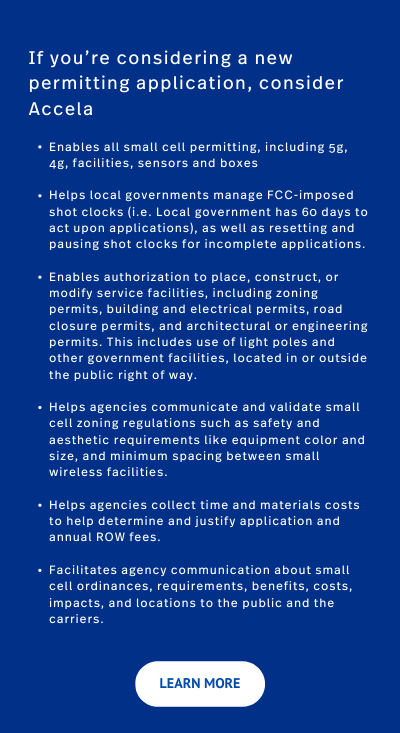Many government agencies expect that 5G is a technology that could support the popular vision of smart and connected cities where services are supercharged through a network of mobile devices, computers and sensors everywhere around us. To realize the full potential of cloud computing platforms and Internet of things (IoT) applications, 5G technology is a potential game-changer.
As a disruptive technology, 5G may spell the end for the legacy systems, protocols and infrastructure that support our current public service delivery infrastructure.
Ultra-fast 5G infrastructure has the potential to connect government buildings, vehicles and equipment in near real-time. The result is a generation of smarter, faster government services far beyond the limitations of today’s technology. Since future smart-city infrastructures will rely on real-time communications, a 5G-powered internet of things (IoT) in the cloud is a necessary foundation to build upon.
5G Advantages
Speed: 5G delivers the biggest leap forward in network speed to date. The catapult from 4G to 5G is accelerating internet speeds up to 100 times faster than current networks.
For comparison, at 4G speeds, it currently takes about seven minutes to download a movie in HD. On 5G, that time is reduced to about six seconds, potentially saving users nearly 24 hours of download time per month according to PC Magazine. Certainly, 5G can be a game-changer for government services like 911 calls and fire departments in terms of significantly faster communications and response times. Features like location-based routing reduce the need for 911 call transfers to speed connections, according to T-Mobile.
5G, that time is reduced to about six seconds, potentially saving users nearly 24 hours of download time per month according to PC Magazine. Certainly, 5G can be a game-changer for government services like 911 calls and fire departments in terms of significantly faster communications and response times. Features like location-based routing reduce the need for 911 call transfers to speed connections, according to T-Mobile.
Latency: When we talk about network speed, we’re typically talking about how quickly we can download data or files. Latency refers to the data uploads, such as the time required to have data on your phone upload to a network and reach a destination server. The potential for the fifth generation of wireless mobile networks is much faster and offers more secure communications between mobile devices and sensors. Reduced latency is great news for govtech apps built on cloud computing platforms.
Security: In actuality, 5G security presents its own unique set of advantages and challenges. There’s little debate that 5G will support much faster and more reliable connections between devices. And all data sent over a 5G network is encrypted, according to TechRadar. But all new technology standards bring their own challenges. More third-party suppliers and nodes will operate on emerging 5G networks, which means more potential failure points and opportunities for bad actors.
5G Challenges
Blocked connections
From 4G to 5G and beyond, each generation of improved technology means moving to a higher frequency range. Higher frequencies enable data transmission at much greater speeds, but 5G transmissions also are more easily blocked, according to Ozy. That means 5G transmissions don’t go around obstacles like buildings or trees, they simply bounce off or are blocked.
Global standards & infrastructure
Since 5G has thus far been implemented in only a few countries, global standards have yet to be documented or agreed upon. And 5G certainly requires extensive infrastructure changes, including new devices with new sensors and chips to accommodate intelligence (AI) capabilities. We will also need to re-imagine regulations that were designed with giant cell towers in mind, not of thousands of small cells that must be densely integrated into our current city infrastructures.
Small cell installation
Since 5G can’t cover the same area as a 4G cell tower, our challenge is to efficiently deploy small cells to support 5G performance. In contrast to large cell towers, small cells typically have a range of less than 500 feet and must be placed every few blocks, often on street lights, utility poles, and buildings. This means substantially more permits are required for a 5G network to be established.
Smart Cities = Growth Cities
Businesses and consumers increasingly demand the speed and convenience of a 5G infrastructure. Now it’s up to government agencies to meet the regulatory challenges of fast and efficient deployment. There’s little debate that 5G paves the way for the adoption of emerging technologies that are transforming business, government services and our overall quality of life.
Business models powered by emerging tech including artificial intelligence, robots, IoT, and edge computing all benefit from higher speed, lower latency and improved device connectivity and coverage.
As our cities become more smart and connected, they can also become safer, more livable and walkable. A 5G infrastructure, like the pioneering efforts in the City of Sacramento, is expected to help in applications from traffic congestion to reducing CO2 emissions and pedestrian safety measures.
The combination of 5G, IoT, and cloud platform technologies hold the potential to boost local economies, accelerate job growth, and provide a foundation for the future growth of smart cities. Many cities are planning 5G infrastructures with an eye toward attracting new and innovative business models to set up shop in their communities.
The accelerating adoption of 5G probably is the biggest driver of small cell deployments, which are expected to reach more than 800,000 by 2026, according to Cellular Telecommunications Industry Association (CTIA) research. Network providers themselves are also driving influencers. The accelerating adoption of 5G means unprecedented demand for 5G permitting and related civic services — and underscores the need for all government agencies to become more efficient and responsive to the needs of citizens and businesses.
Reinventing the 5G Permitting Process
Though the next generation of mobile technology has arrived with a generous helping of hype, there’s no denying that 5G holds enormous potential to streamline relationships between government agencies, businesses and residents. However, state and local governments are beginning to feel the strains placed by increasing permit requests to establish 5G networks. Permits are required to install small cells and additional permits such as right-of-way permits to facilitate safe installations also may be required,
It’s not surprising that government agencies around the nation are considering cloud-based software solutions to eliminate paper processes and automate 5G permitting. To realize the true potential of 5G and other smart technologies, we must find smarter ways to manage them.
To manage the growing number of applications for small cell installations, cities can leverage the Accela Building Civic Application, a flexible, pre-configured solution designed to accommodate emerging regulations and new permit types — arming government agencies with automated workflows that make reviewing and approving small cell permits quick and easy. Applications can be submitted conveniently through an online citizen-facing portal, while agency staff can manage, track, review and approve incoming requests.
Accela Civic Applications are unique in that they provide a pre-configured set of features and functionality that gets government agencies up and running quicker than traditional permitting software solutions requiring custom code. They’re also easy to maintain, upgrade and support. With faster processes in place, governments can facilitate smart city growth, meet resident demands, and capture permitting revenue faster.
To learn more, download our whitepaper, and see how Accela can help you be prepared for the shift.



